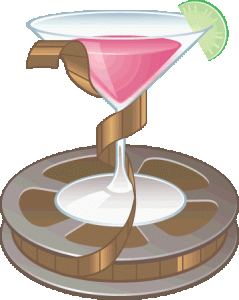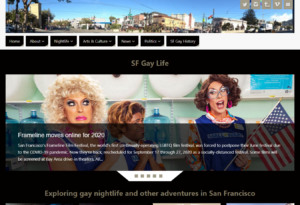Over the years, I’ve created several websites as part of my hobbies and creative pursuits. Here are four that still exist:
Cosmique Movie Awards

In the late 1990s, my friends and I would host annual Academy Awards parties. Like most people’s Oscar parties, we passed out ballots for guests to predict the winners. But I was much more interested in who they wanted to win than who they thought Academy voters would choose. From that was born the Cosmique Movie Awards, named after a local Mardi Gras krewe I was in.
At an Oscars party in 2001, I passed out nomination ballots for our own movie awards. Because it was our first one, we had a lifetime of movies to catch up on, so all of our awards that year were lifetime achievements. Their nominations were tabulated, the top choices were nominated, and separate ballots to choose the winners were sent out later. I deliberately set out to blend the gravitas of the Oscars with the irreverence of the MTV Movie Awards. We had “serious” awards like Best Film of All Time (which The Wizard of Oz (1939) won) and Best Individual Performance of All Time by an Actress (won by Rosalind Russell for Auntie Mame (1958)). But we also had silly awards like Best Film Villain of All Time (a three-way tie!) and Best One-Liner or Camp Quote in Movie History.
The next year, spring of 2002, we were ready to primarily focus on films of the preceding year like the Academy Awards do, with awards for Best Film of 2001, Best Action/Adventure Film of 2001, and Worst Film of 2001.
The first website was created a few years after the awards began. Initially I had separate pages for every nominated film and person. As each was created by hand (with a few shortcuts provided by Microsoft Frontpage), it was quite laborious, and I eventually resorted to lists of nominees and winners rather than individual pages for each.
Finally in 2019, I gave up on the static website and created a new one in WordPress on a new domain. Much better, though I still dream someday of having individual profile pages for every nominated person and film.
Twenty years later, the awards are still going strong. To date, a total of 1,217 different films have received one or more nominations, with 364 of them winning one or more awards. Over 751 individuals have received at least one nomination for acting and/or directing, and 223 of them have received at least one award.
Big Gay Frat House

Several friends of mine and I bought a small three-unit apartment building in the Castro in 2005. For a time, we lived there communally as if it were one big house with common space and private space. We each had our own bedroom and office, but we only needed one kitchen (one became a costume “closet” with multiple garment racks of Halloween and Mardi Gras costumes, while another was initially used primarily for storage).
After a massive (and massively expensive) Epiphany Party in January of 2006, we decided to start throwing charity fundraisers for local LGBTQ+ nonprofits. We branded ourselves as the Big Gay Frat House and converted our three-car garage as a stage for the events. The first full year, we had two big events: the Balls-Out Ball, a fundraiser for the SF Fog rugby team, with special guest star Varla Jean Merman; and A Midsummer Night’s Dream, a fundraiser for Community United Against Violence with guest host Brent Corrigan.
The following year, we tried to do “turn-key” fundraisers. We had relationships with alcohol distributors, drag queens, and go-go boys. We’d provide the entertainment and operational support, while the beneficiary charity would recruit volunteers to staff the bar, coat check, front door, security, and clean-up.
Over the course of a few years, we raised over $30,000 for eleven local charities like the AIDS Emergency Fund, Project Open Hand, the SF Lesbian/Gay Freedom Band, and SF Boylesque. We were even the subject of a mini-documentary available on YouTube.
But all good things must come to and end. Eventually, neighbor noise complaints about our once-a-month parties wore on us (even though they were all on Saturdays and ended promptly at 11:00 p.m.), and the events were a lot of work.
The BGFH website was created old-school by hand and with Frontpage. When I migrated my new sites to a new hosting company, most of them were already using WordPress, and I recreated the Cosmique Movie Awards to take advantage of WordPress’ functionality. The website for the BGFH was also brought over, but left unchanged as a static memorial to our efforts and accomplishments.
SF Gay Life

The financial collapse of 2008 contributed in the company I worked for, Gay.com, getting acquired by a company in Los Angeles, and a majority of us were laid off in January of 2009. (At least I got to be home with mimosas for Barack Obama’s inauguration.)
Eventually I decided to create a website, SFGayLife.com, as a showcase for the amateur gay nightlife and event photography I had been doing. This was never anything I was ever paid for, though some of my photos ended up in Gay.com’s Local Scene section (which sadly no longer exists). I figured ad revenue could cover the costs and provide a financial boon during my unemployment.
Unfortunately, though the website was popular — too popular, as it turned out — it was never a financial success. Google considered the photos to be too risqué and wouldn’t allow me to use Google AdSense, which would have been the most lucrative route. I replaced those ad slots with affiliate ads from underwear companies and others who were okay with edgier content, but they never resulted in any sales. Not one penny.
I created a fancy marketing portfolio with lots of demographic information about the traffic I was getting — and it was a lot of traffic for a hobby site with zero marketing budget. I created an infrastructure where I could sell targeted ads. I had the ability to sell ads to a gay bar that would appear on every nightlife post about that bar, and to club promoters for every post about their events. Unfortunately, that never paid off. The traffic was too much for my meager shared hosting plan, and my web host routinely shut my site down temporarily when the traffic became too much. I was also facing daily attacks from Russian hackers trying to capitalize on my site’s infrastructure.
I couldn’t justify upgrading to a better but more expensive plan when the site still hadn’t generated a penny of revenue. I eventually disabled all of the photo galleries and put up a notice that I was considering different options for how to proceed, including trying to host the photos on third-party sites. Unfortunately, which the photos were not pornographic, they were still considered to be too “edgy” for most photo hosting sites.
When I migrated my sites to a new hosting site, I decided to keep but revamp SF Gay Life. The design was largely kept, but the content was revamped to be more of a peek at upcoming gay nightlife events. I created separate Twitter feeds for San Francisco’s gay nightlife, arts & entertainment, news, and politics, which allowed for a stream of fresh content even when I didn’t have time to curate it. And the content was tame enough to allow me to use Google AdSense, though probably too tame to generate the same kind of traffic I was getting before.
The revamped site went live in November of 2019. Not six months later, gay bars in San Francisco — and all bars — had to shut down due to the COVID pandemic. Though I have had some new (mostly virtual) events posted since then, the site is largely dormant except for the Twitter feeds until nightlife can return to some semblance of normalcy.
SF Gay History

When SF Gay Life turned out to be a financial bust, I turned to another interest of mine that might be more advertiser-friendly: the history of San Francisco’s LGBTQ community. I had tons of books about Harvey Milk, Jose Sarria, and other gay historical figures. And I had years of notes about the history of gay bars in the City, particularly the history of gay bars in the Castro.
I created a timeline of LGBTQ history in the City as well as a This Day in History feature that I’m quite proud of. One of my most popular posts was a four-part history of gay Halloween in San Francisco, which even merited a bulleted shout-out from Towleroad.
SF Gay History has been a lot of fun, but is an awful lot of work. It’s also been the highest revenue-generator, though it only earns a few dollars a month, hardly enough to offset the domain registration and website hosting expenses. It’s a hobby, not a side-gig.
Goebel.gay

I hadn’t even thought about creating a personal website. I felt that the four domains I already registered spoke for themselves. But then in September of 2020, George Takei announced that he had registered the domain of George.gay (which redirects to the LGBT section of his GeorgeTakei.com website). That was the first time I heard that a .gay top-level domain was going to be available.
My own hosting company wasn’t authorized to sell or host .gay domains, but I found another site that did. I started poking around looking for domains to buy. Unfortunately, popular names and terms were already being sold for jacked-up prices, and I couldn’t justify spending hundreds or even thousands of dollars to buy Kevin.gay or SanFrancisco.gay. But when I discovered that my surname was available at the standard rate, I snapped it up.
But what to do with it?
I had no pressing need for it, but I figured I’d let it be a showcase for my portfolio — writing samples, photography samples, and these hobby websites.
I also thought it could be a good place to host information for the (yet unplayed) Dungeons & Dragons world I’ve been tinkering with, called Adnati. I found a WordPress plugin that makes it easier to create a Wiki for the world, which would allow adventurers to learn about their world and its people, and make it easier for them to look up the name of an NPC they encountered, or refresh the details about a particular god or religion. It could also allow them (and me as DM/narrator) to record a log of their adventures. And in the meantime, it makes for a convenient way for me to organize the dozens upon dozens of MS Word documents (and Excel spreadsheets!) I’ve been creating over the years.
The cover art is an illustration of the ancient Library of Alexandria, which I felt nicely tied together my nickname of “the Royal Scribe” (which was bestowed upon me on August 12, 1989) with the medieval/fantasy setting of my D&D world.
